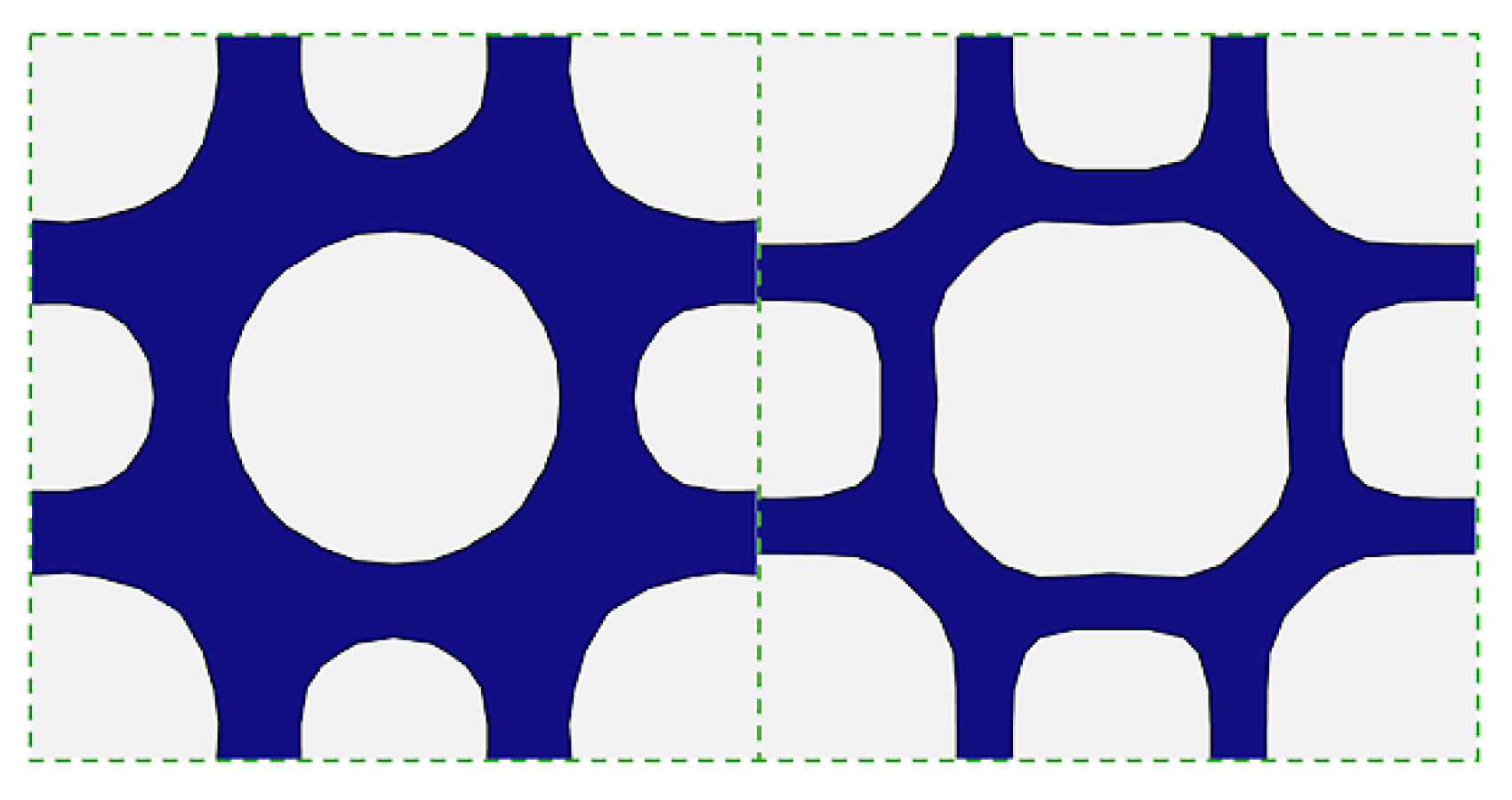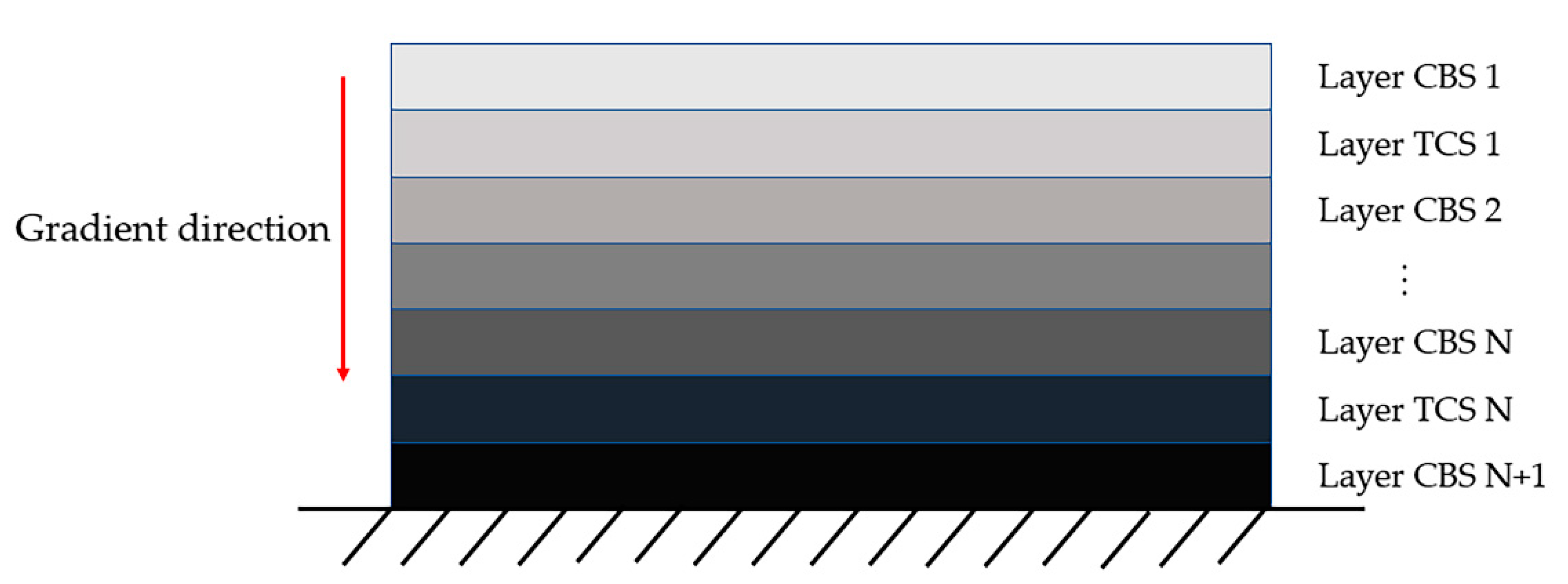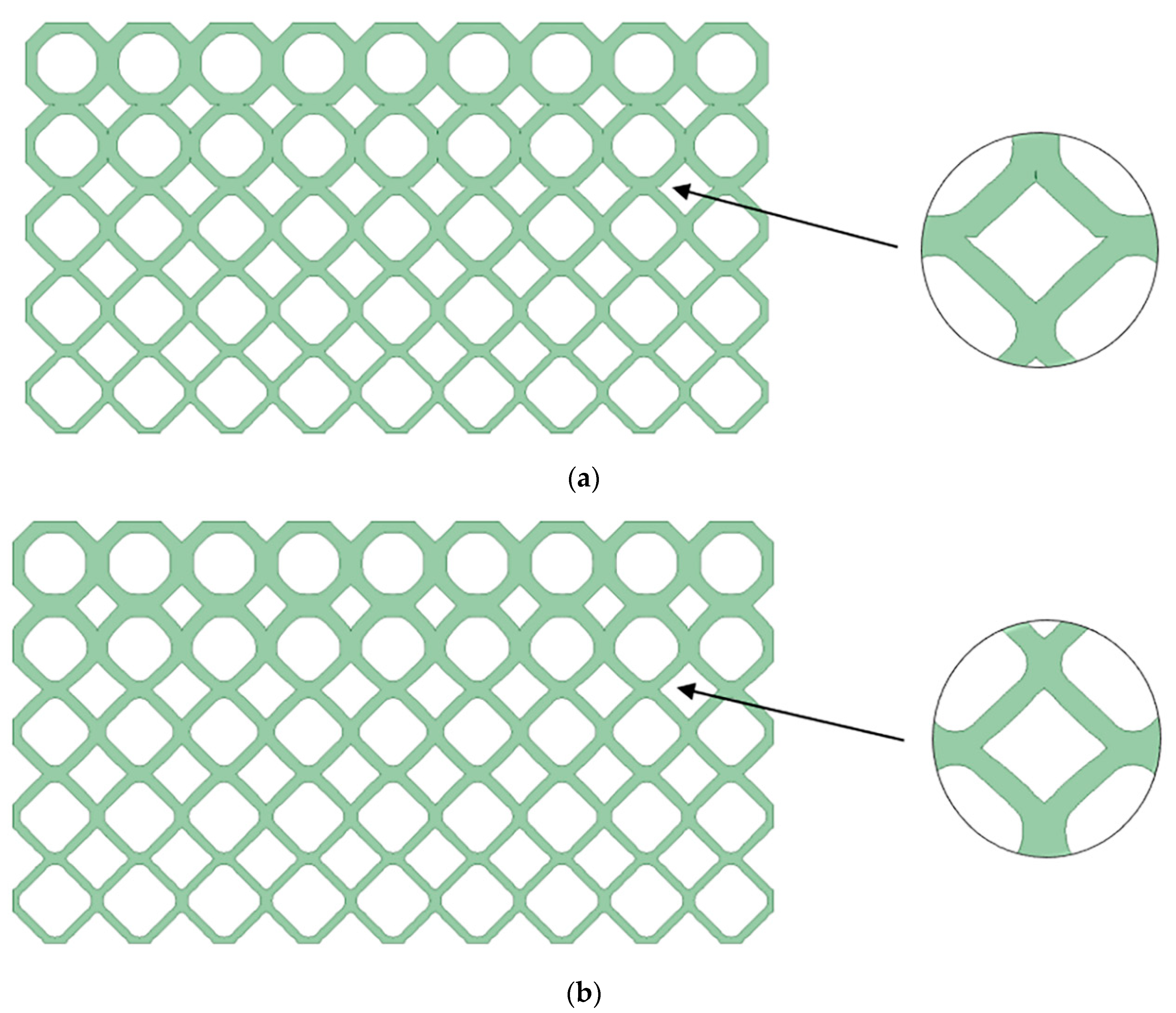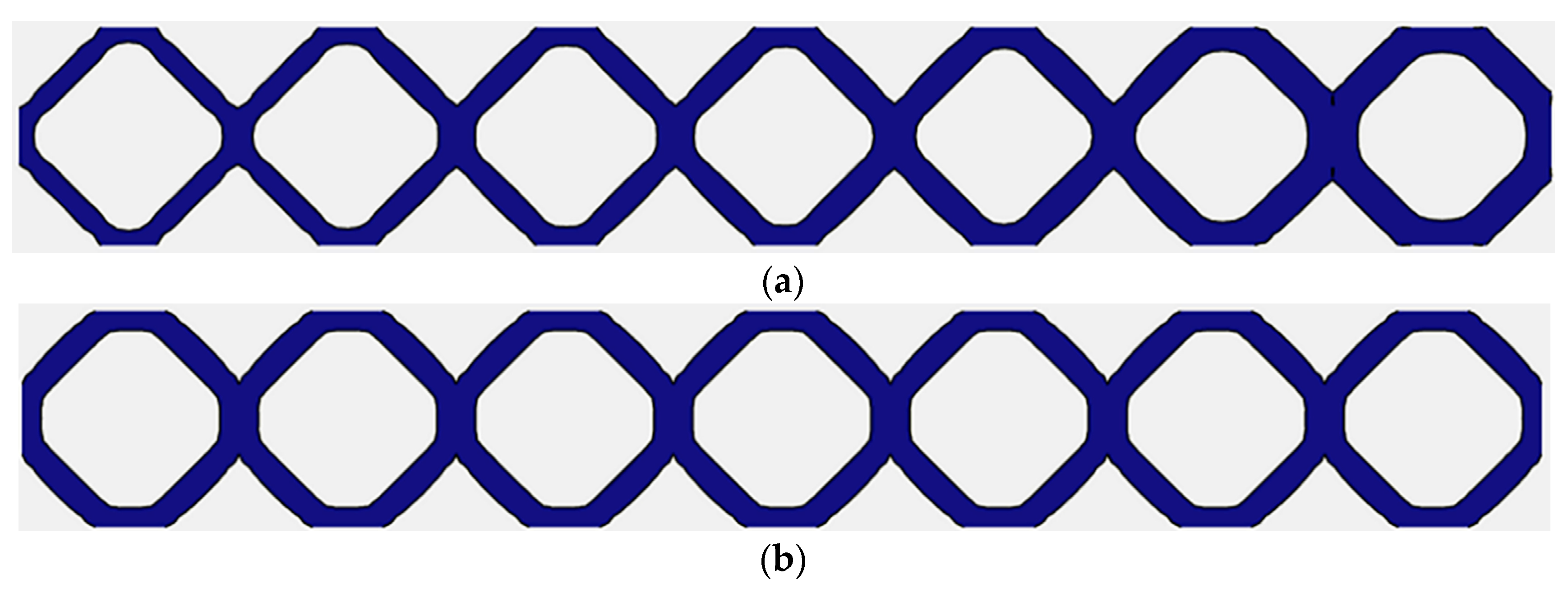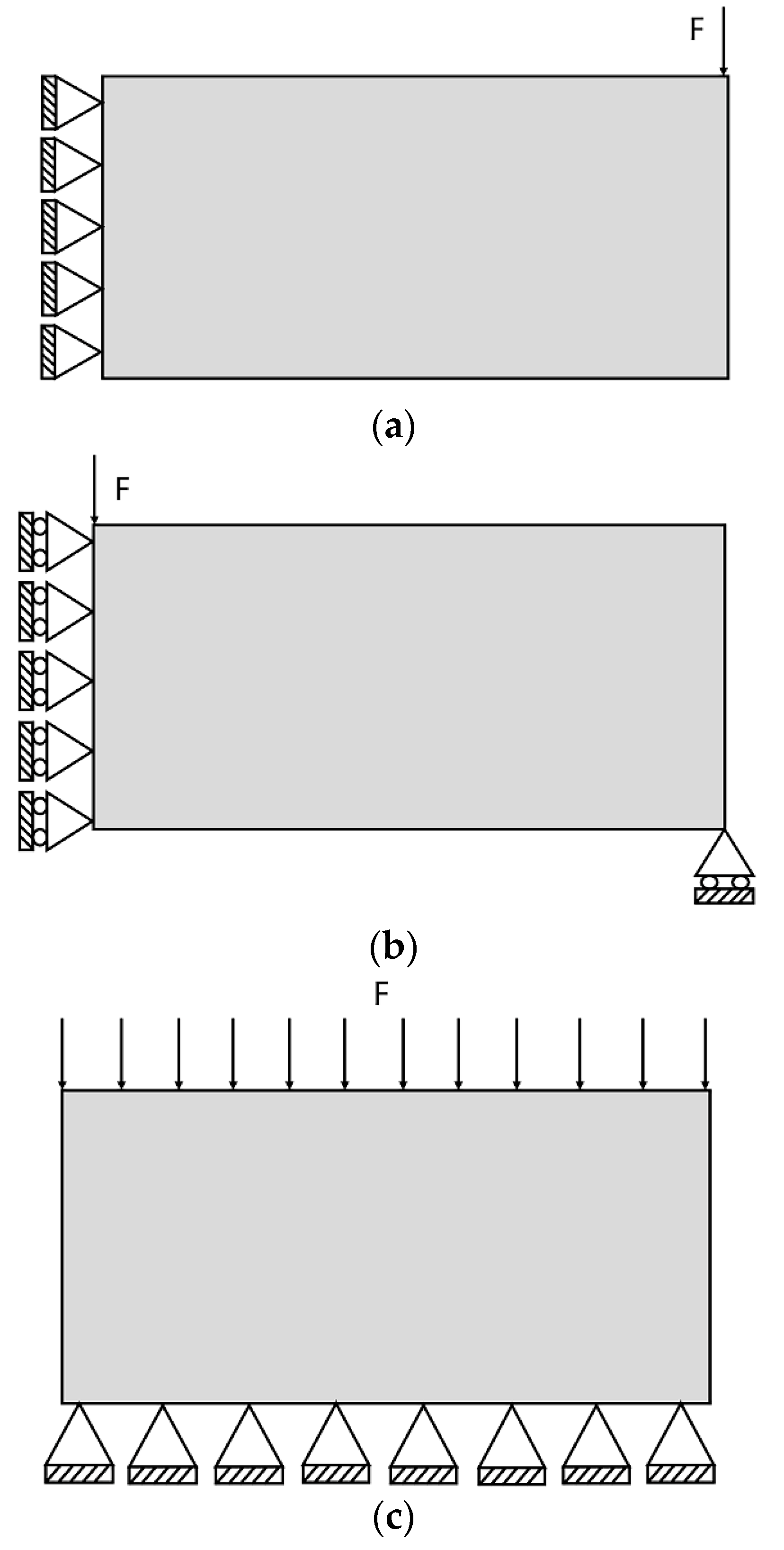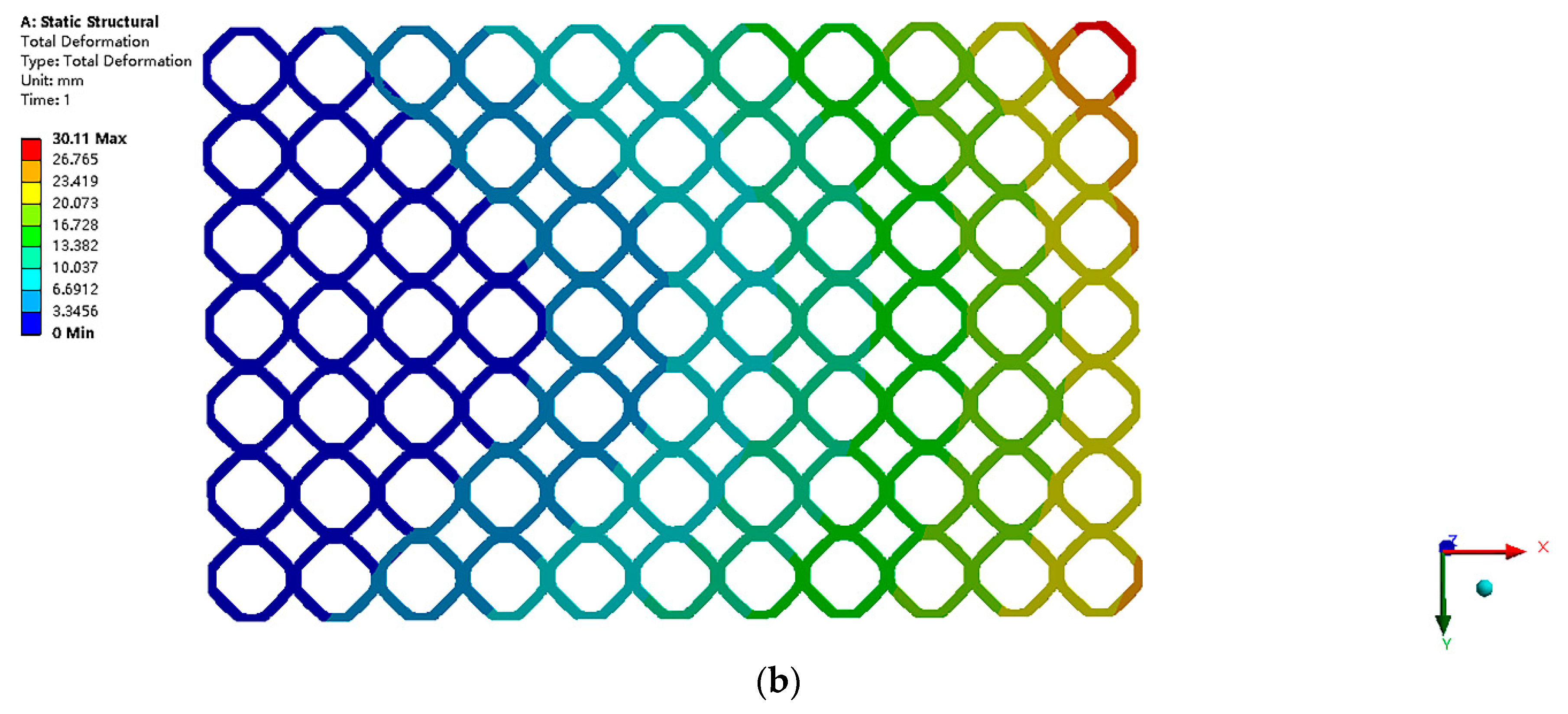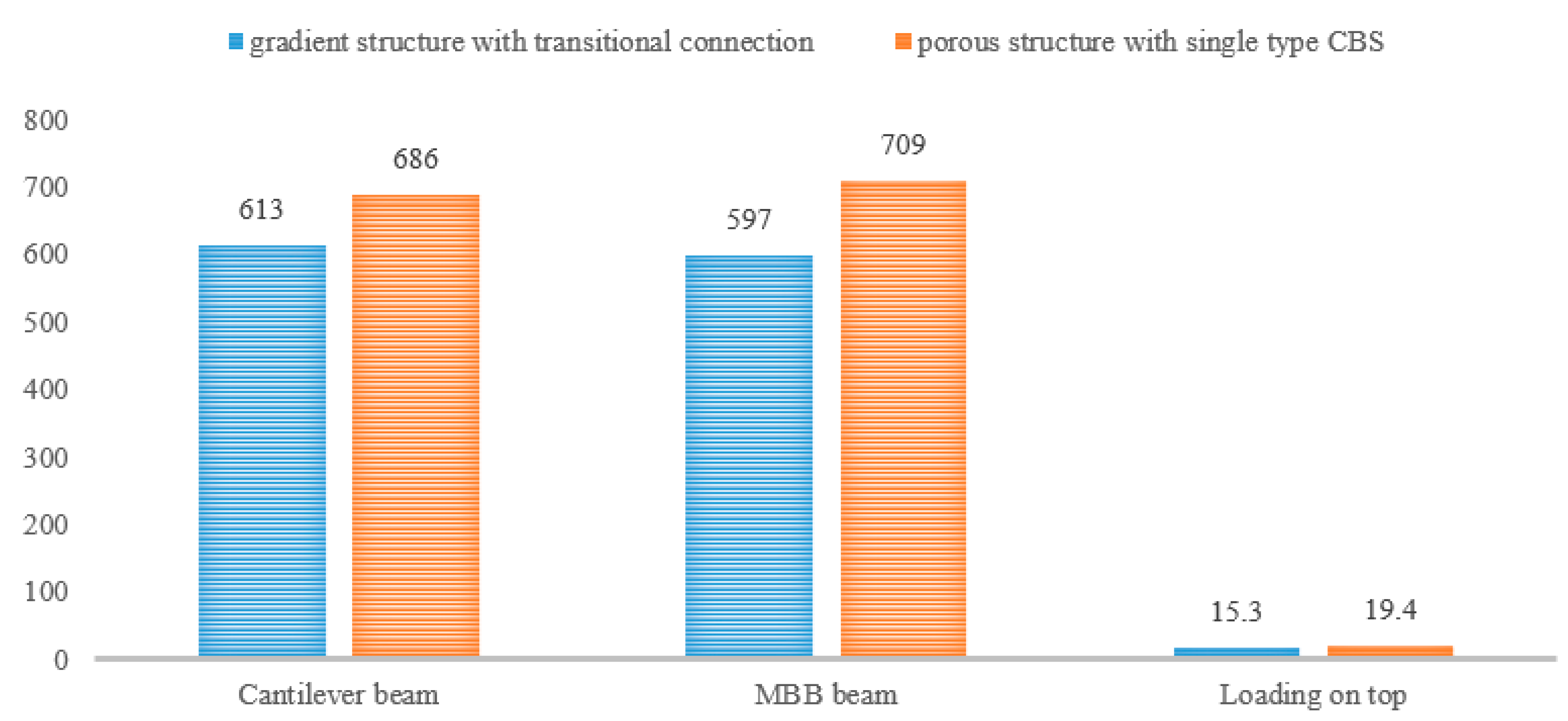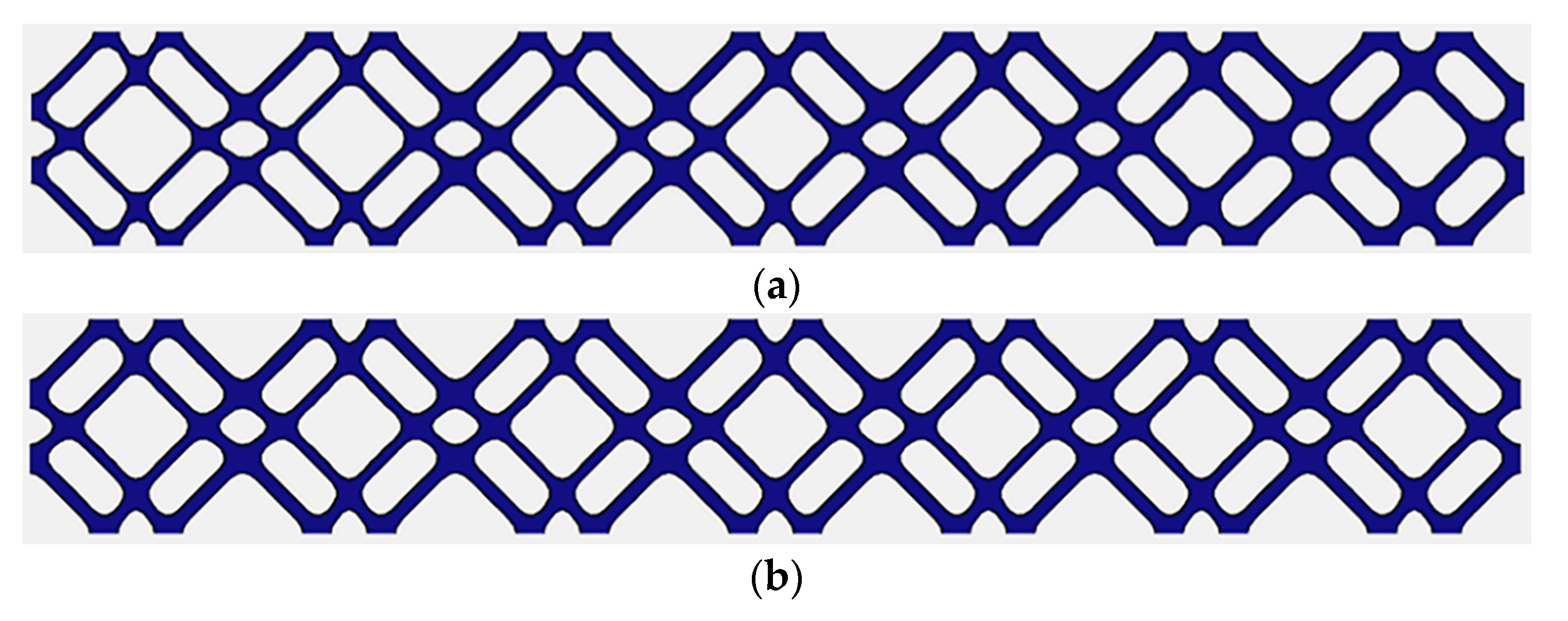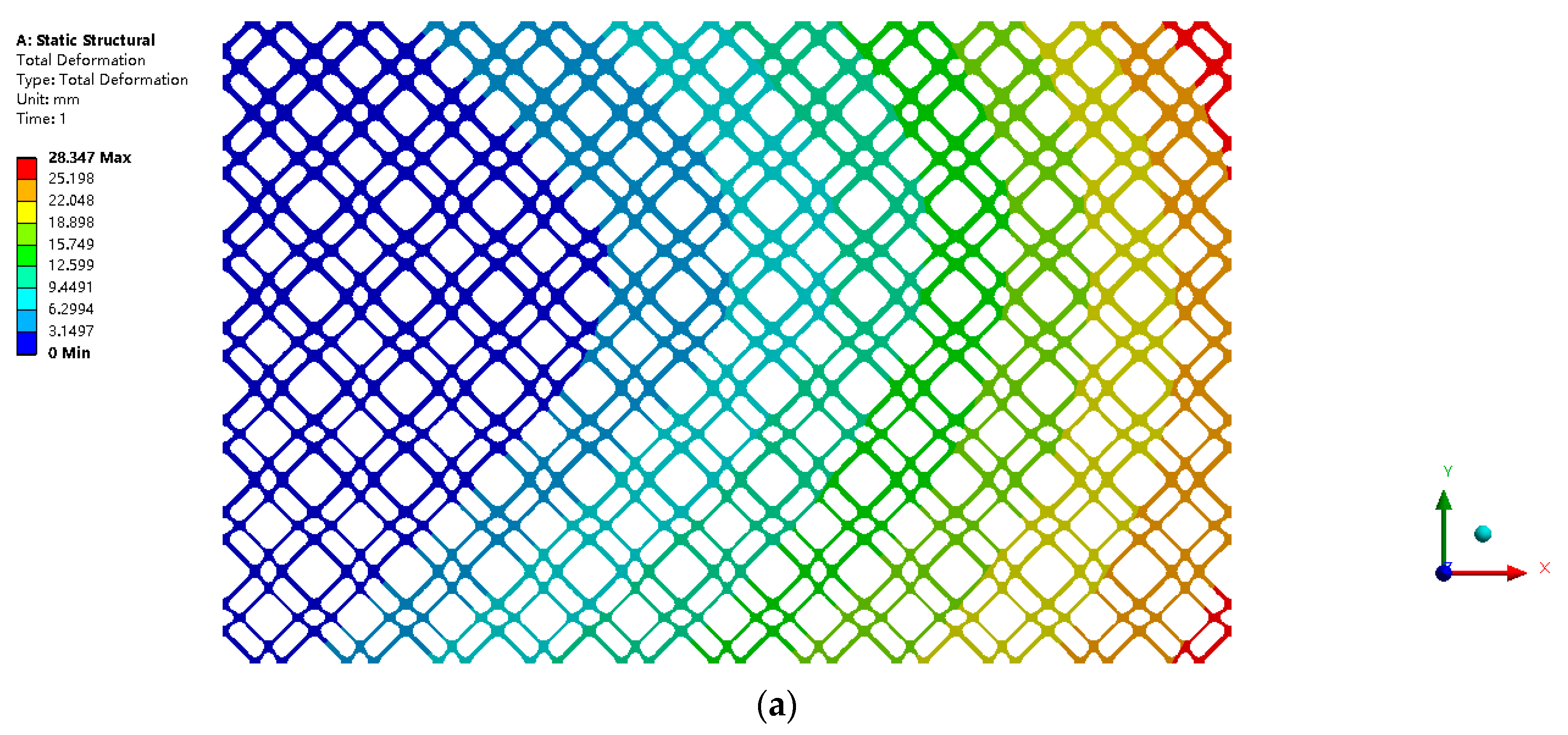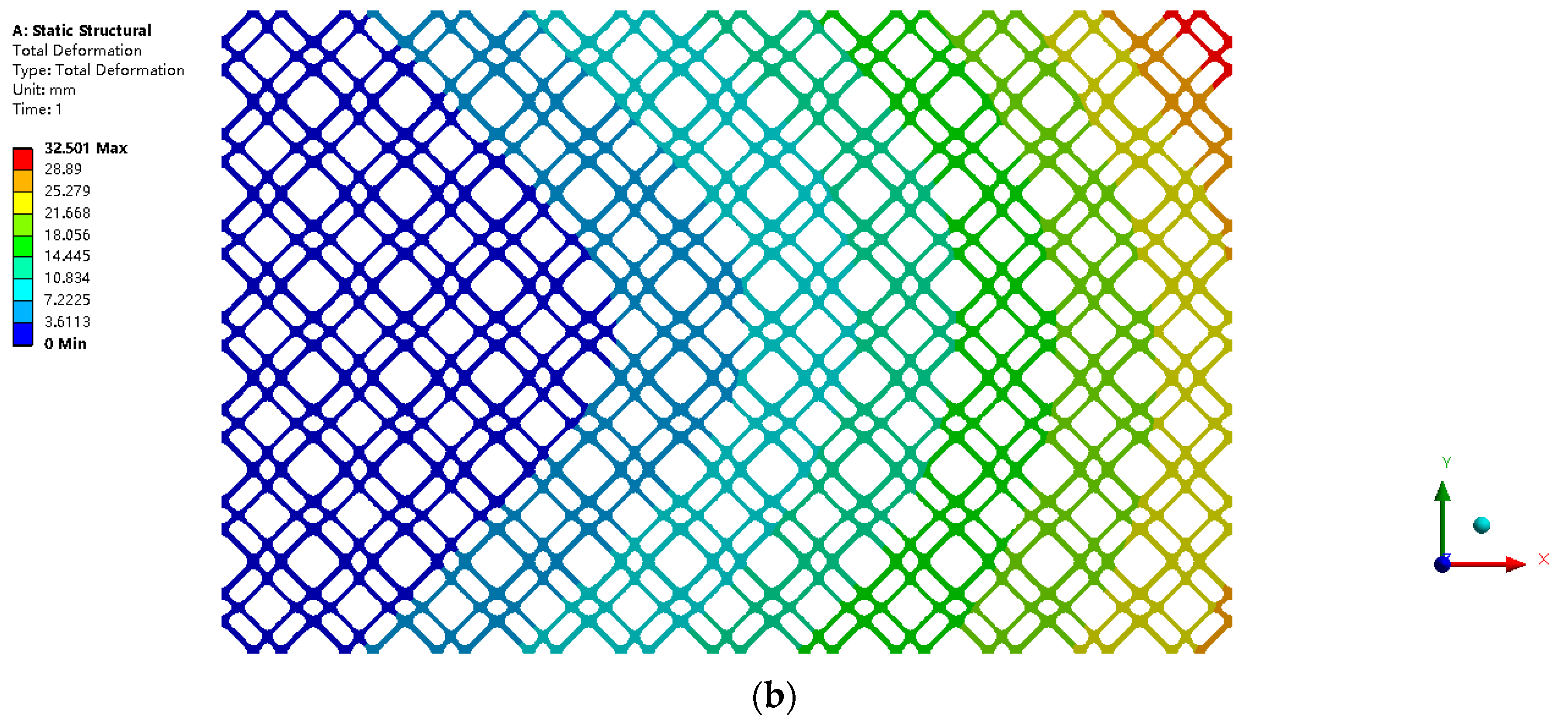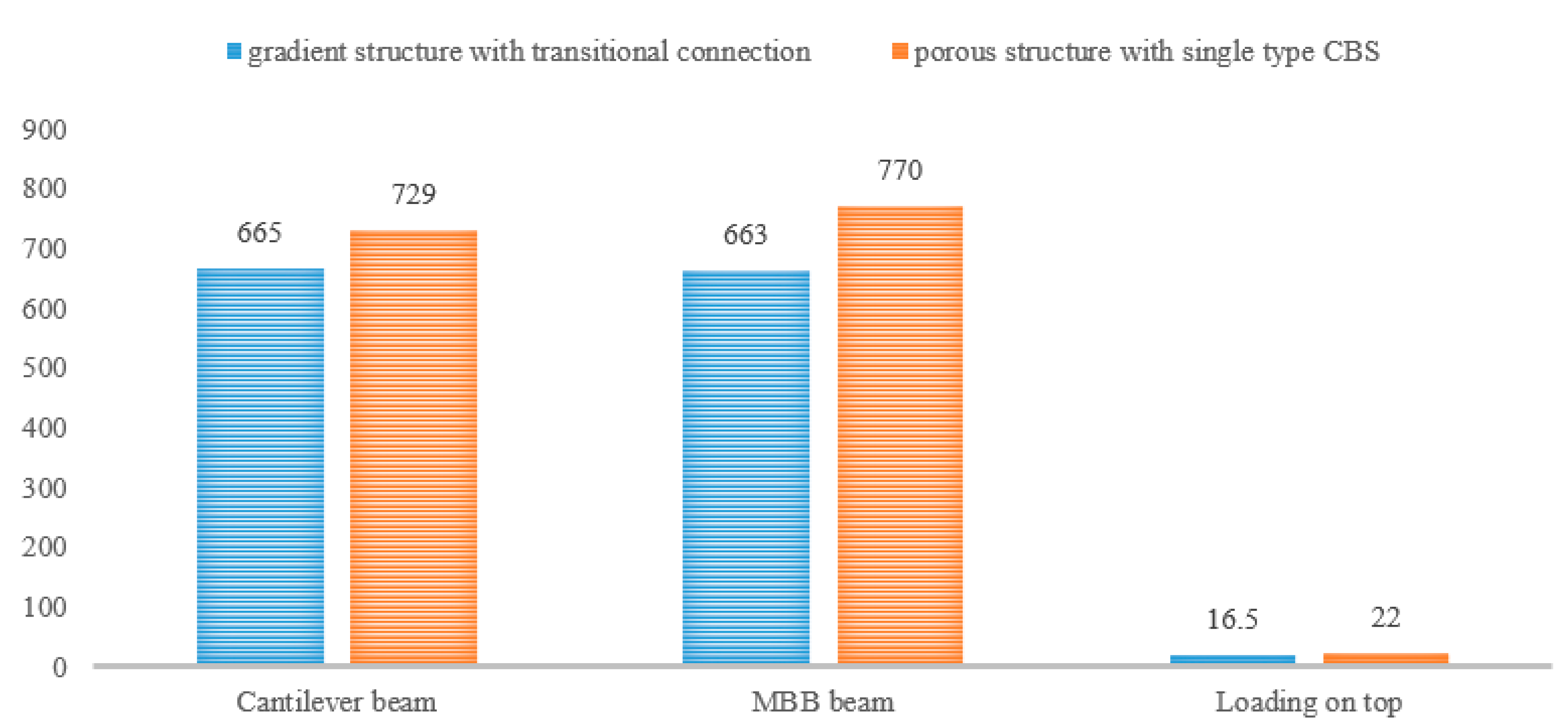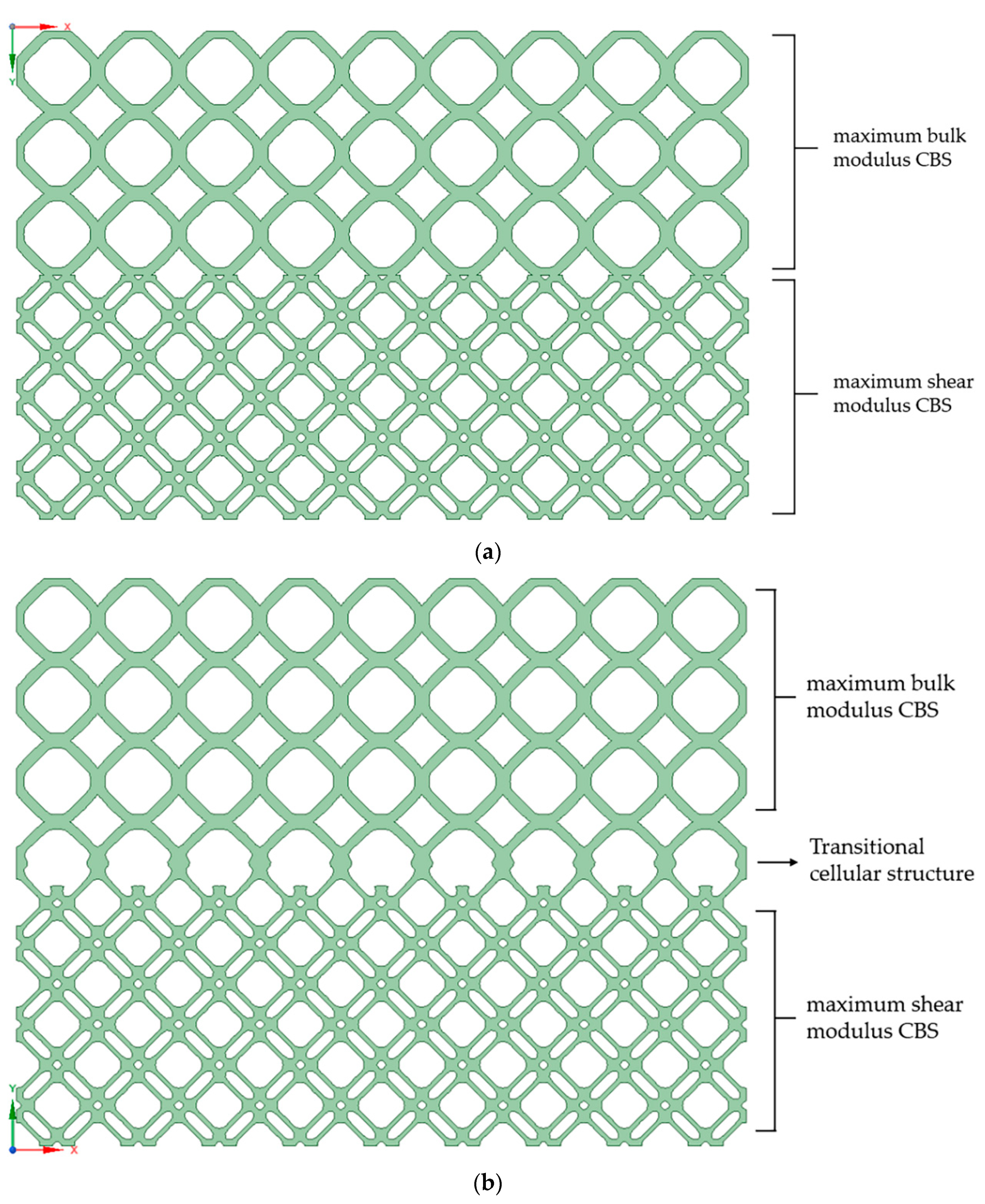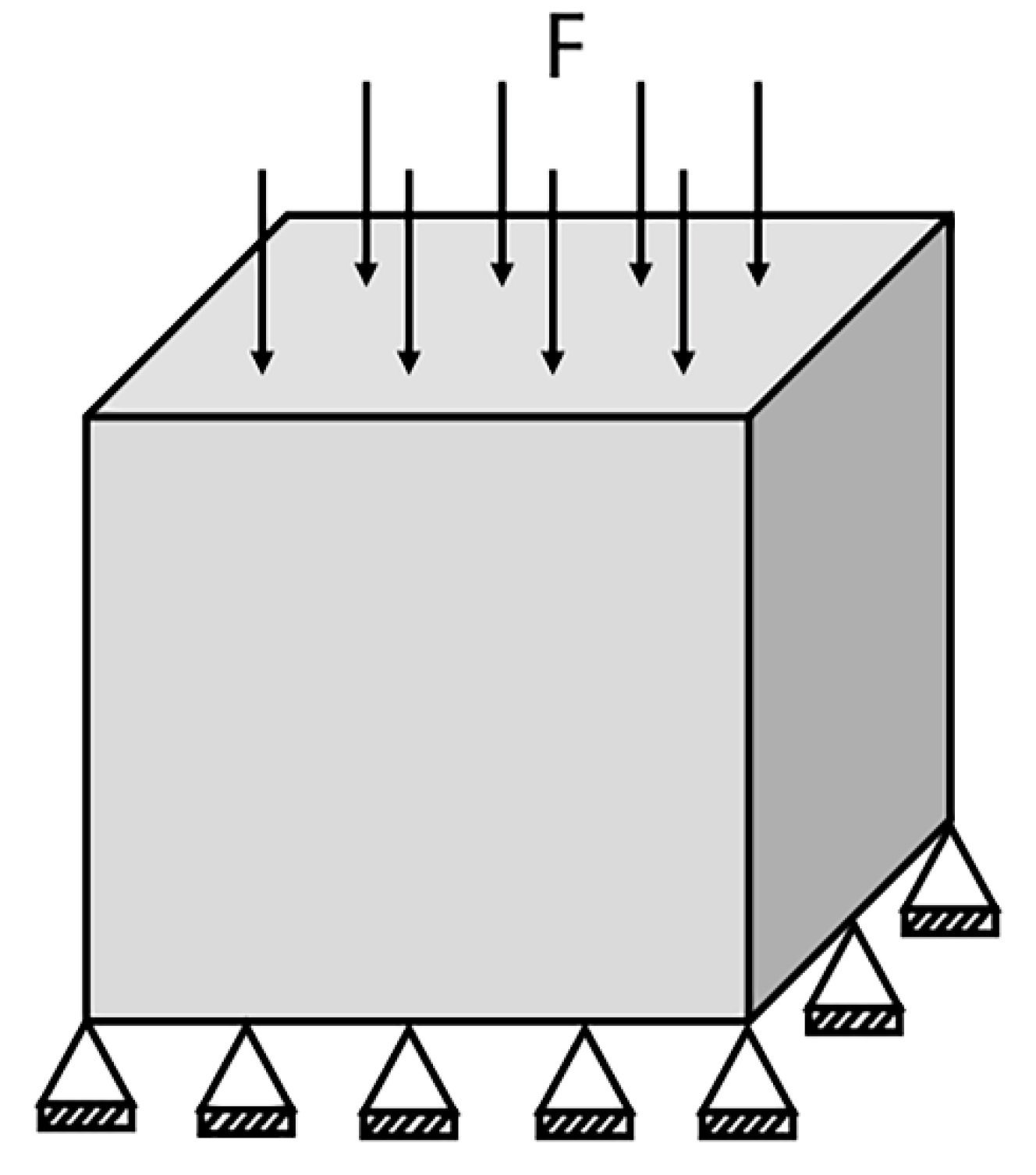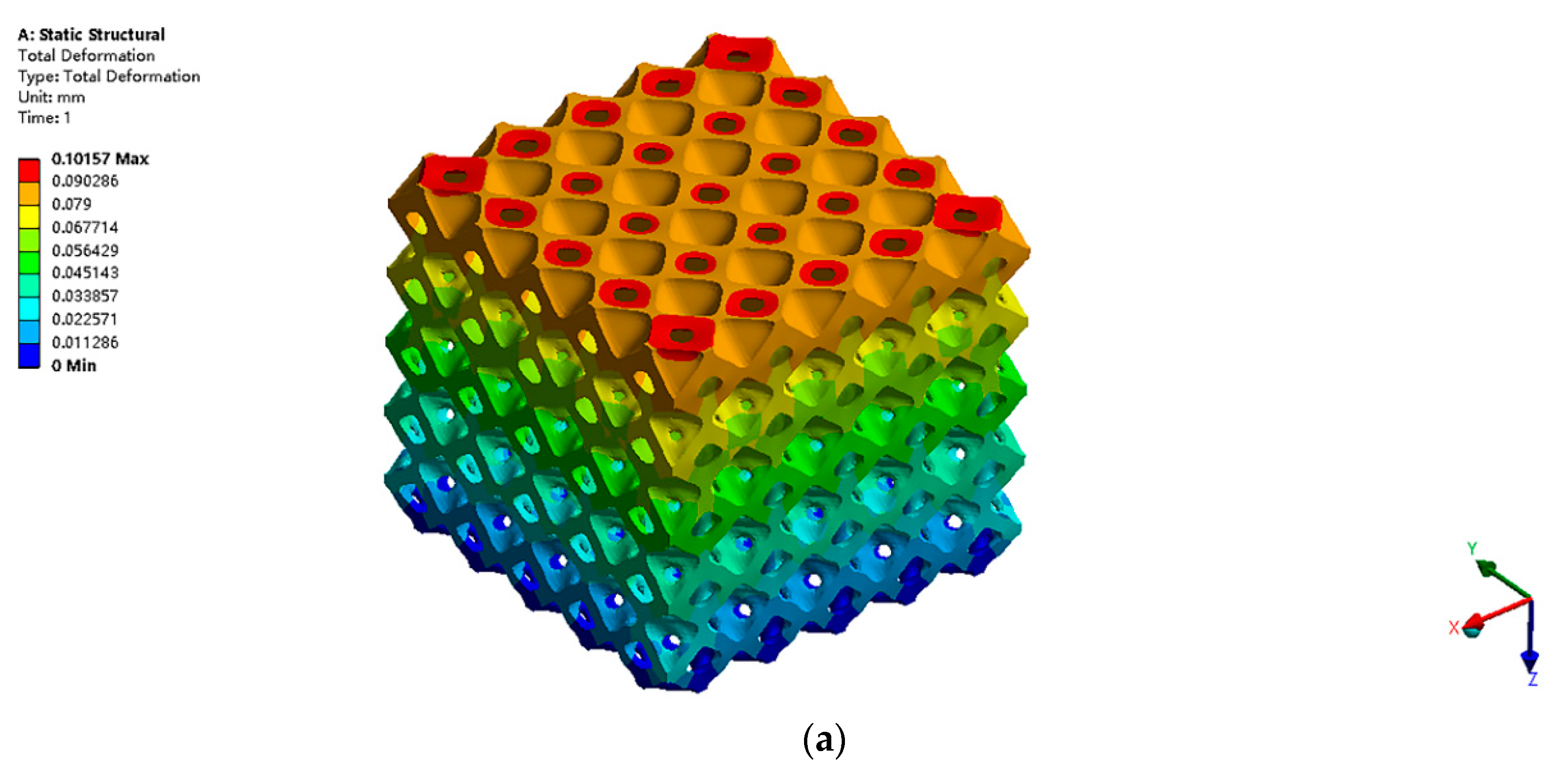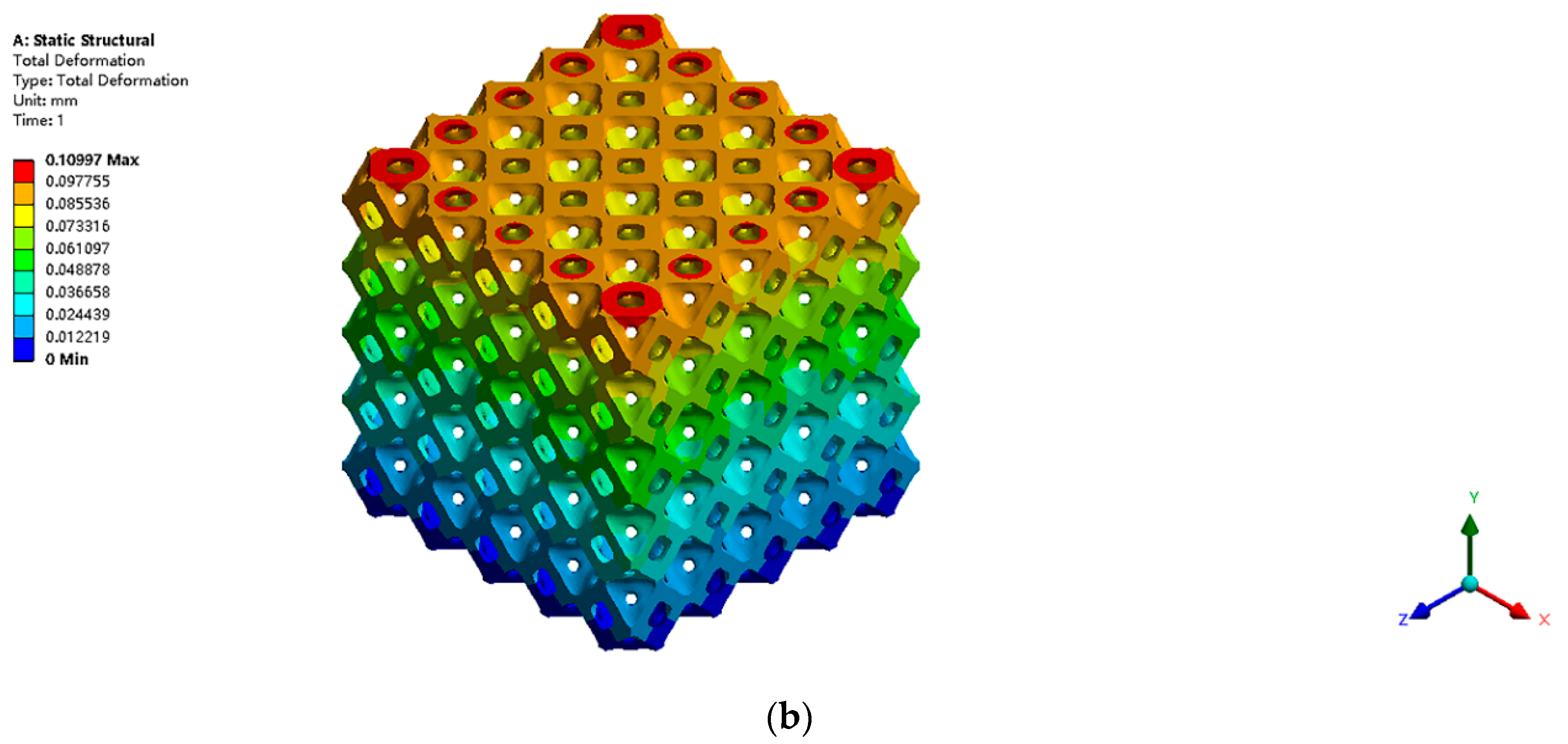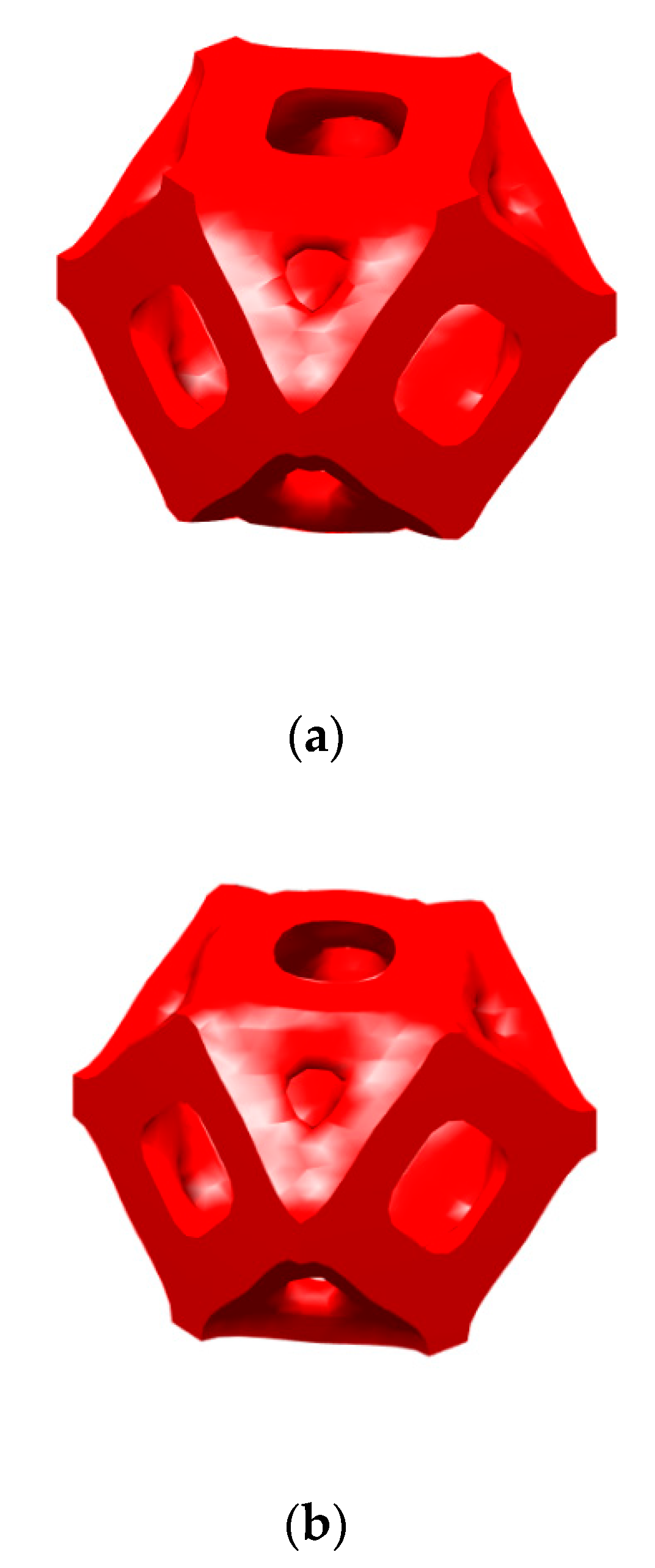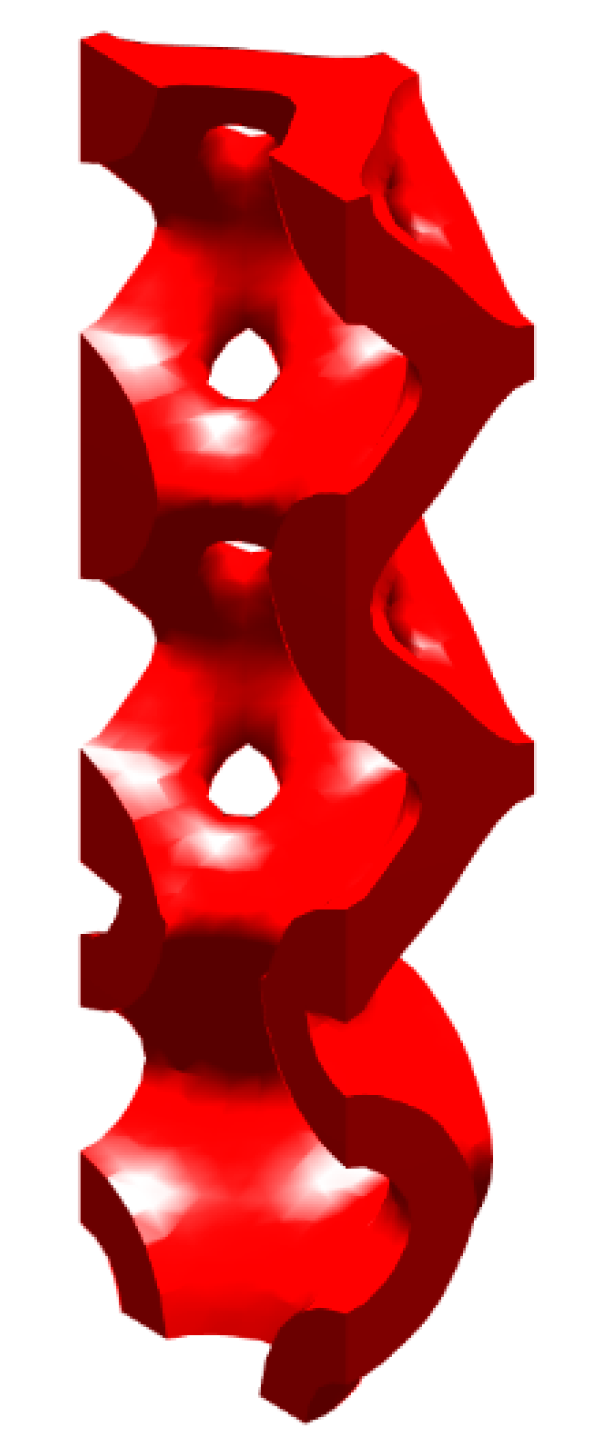1. Introduction
Organisms like bamboo, to adapt the environment [
1], often consist of a gradient structure. Inspired by the materials that already exist in nature [
2], functionally graded materials (FGM) is usually composed of continuously varying cellular structures in one direction and self-repeated in the other direction. Due to their excellent performances, FGM has been extensively studied and reported [
3,
4]. In particular, this study focuses on the man-made FGMs constructed by a series of porous microstructures due to their design flexibility and high performances [
5]. With the development of additive manufacturing, the fabrication of complex cellular structures has become possible and artificial FGMs are also widely utilized in engineering applications [
6,
7,
8]. However, cellular FGM often contains complex and spatially varying microstructures. It is difficult to simultaneously devise all the different microstructures and ensure their connection at the boundaries. Because different microstructures usually have different topologies, and there often lacks a proper mechanism on the macro scale to connect all the microstructures, especially when tailoring the FGMs with the topology optimization [
9,
10,
11].
Over the past few years, for the design of the cellular structures, researchers have widely adopted topology optimization (TO) technology and the numerical homogenization method [
12]. Topology optimization is regarded as an effective structure optimization method by using the finite element method (FEM) and advanced optimization algorithms. Under the given boundary and loading conditions, TO takes the structural performances as the design objective and gradually achieves the optimal material distribution within the design domain [
13]. Up to now, several TO methods have been developed, e.g., the homogenization method [
14], solid isotropic material with penalization (SIMP) method [
15,
16], evolutionary structural optimization (ESO) [
17,
18], level set methods (LSM) [
19,
20,
21,
22], and so on. There are many other ways to describe the configuration of the structure, such as the SIMP approach based on non-uniform rational basis spline (NURBS) framework [
23,
24,
25]. Moreover, the numerical homogenization method has been developed as an efficient tool to evaluate effective properties of the periodic porous materials [
26]. Considering the scale effect, the above cellular solid performs more like a material whose elasticity tensor can be approximately calculated by imposing periodic boundary assumptions. For the topological optimization design of periodic cellular materials, the incorporation of the topology optimization scheme with the homogenization theory can automatically devise the geometrical configuration of cellular structures with extreme performances, such as maximum bulk or shear modulus [
27], negative Poisson’s ratio [
28,
29,
30], thermoelastic property [
31], and so on. On the other hand, cellular structures with desired properties can also be tailored by utilizing an inverse homogenization procedure [
32,
33]. The above studies mainly assume that the whole design domain consists of a number of uniform cellular materials. However, FGMs with spatially varying cellular microstructures always have more design freedom and can facilitate the exploration of combined functions for real-world applications [
6,
34].
FGM can be regarded as a kind of artificial composite that can continuously change their volume fraction, composition or microstructures, so as to adapt to the service environments [
35]. Therefore, mechanical performances (e.g., stiffness, strength, and toughness) of the FGM can be greatly improved when compared to the traditional materials with uniform cellular structures [
3]. However, how to achieve FGM properties via the change of material constituents or porous microstructures over layer or volume is always a difficult task. In later studies, researchers focus on the design of the cellular structure with specific performances [
36,
37,
38] or gradient properties [
30,
39] by using the discipline of topology optimization. Particularly, for an FGM composed of cellular structures, the connectivity issue along the gradient direction has to be considered. Otherwise, the fabrication of the FGM structure is not able to be guaranteed [
40,
41]. As a result, many researches have been done for tackling this specific issue in the topology optimization of FGMs. For instance, Zhou and Li [
9] systematically proposed three different approaches to solve the connectivity issue between adjacent cellular structures, and made an in-depth discussion about the connection effect. Radman et al. [
10] devised a way to optimize all three cells simultaneously, and developed a filtering scheme to enhance the connectivity between different material microstructures. Cadman et al. [
11] used a kinematically connective constraint approach to guarantee the connectivity of the neighboring cellular structures. Zong et al. [
42,
43] proposed a VCUT level set method to generate functional graded cellular structure, where a high-order continuity between the graded microstructures can be achieved. Maskery et al. [
44] investigated the surface-based FGM, and illustrated the connection issue between completely different unit cells. Above-mentioned studies revealed that while considering the connectivity, the smoothness of the boundary makes a significant impact on the mechanical property and manufacturability of the cellular FGMs [
40,
41]. However, the existing methods used to tackle the connectivity problem are usually coupled with the optimization process, which may reduce the efficiency of the optimization process and increase the complexity of the design formulation. An efficient method that is independent of the optimization process can alleviate this issue.
Level set methods [
45], owing to their perfect description of the smooth boundary, are effective ways to divide solid and void parts of the structure in topology optimization. This favorable feature of the level set methods makes it to be considered as a favorable candidate to handle the connectivity issue in the topology optimization design for FGMs. The main concept of LSM is to describe a low-dimensional structural geometry with the high-dimensional level set function, and the zero level set represents the structural boundary. In the classic level set method, the structural boundary propagation is governed by solving the Hamilton–Jacobi partial differential equation (H-J PDE) [
19,
46], which usually requires complex numerical schemes. Furthermore, it is not easy to incorporate the classic level set method with the well-established structural optimization algorithms, like the optimality criteria (OC) method [
47], the method of moving asymptotes (MMA) [
48], and so on. In order to use the existing optimization algorithms and reduce the computational complexity, several alternative LSMs [
49,
50,
51] have been developed. Especially, the parametric level set methods (PLSM) use the radial basis functions (RBFs) [
52] to interpolate the level set function, and thus the time and spatial variables in the level set function are decoupled. In this fashion, the complicated H-J PDE-driven topology optimization problem in the traditional LSM can be converted into a compact parameterized optimization problem, which can be easily solved by the gradient-based algorithms. This study adopts the PLSM due to its high efficiency.
Based on the above considerations, this paper systematically investigates the topological optimization design of FGMs, from the generating of cellular structures to the connectivity of adjacent microstructures. In this study, the cellular FGMs endowed the property of extreme bulk or shear modulus are devised by using the incorporation of the TO method with numerical homogenization theory. Specifically, a PLSM is employed to ensure the smoothness of the boundary, the numerical homogenization method is introduced to evaluate the microstructural property, and the OC optimization algorithm is applied to iteratively update the design boundary until the final design is achieved. Based on the characteristics of level sets, this study proposes a simple but efficient hybrid level set scheme to solve the connection issue. For the two gradient base cells that are separately tailored by the PLSM, a special transitional cell is constructed with the level set function of the existing base cells. This transitional cell contains the geometry characteristics of both the two gradient base cells, and the interface with C1 continuity between gradient cells can be guaranteed. Because the transitional cell is the interpolation result that is out of the optimization loop, the efficiency of this method can be ensured. More importantly, the introduction of the transitional cell will not affect the upper optimization design results by using the PLSM and numerical homogenization. Several FGM design examples in both 2D and 3D are provided to show the merits of the proposed method. To prove the validity of this method, examples of the proposed transitional connection (C1 continuity) and conventional gradient connection (C0 continuity) for the FGM design are given, and comparative simulation analysis has been performed. Moreover, the proposed method is also applicable to the hybridization of different types of cellular structures.
3. Transitional Cell for Connectivity
In this article, the FGM is formulated by a family of cellular base structure (CBS) with different layouts or shapes. In order to enable the gradient change in the FGM, geometric differences between two connected cells along the gradient direction are bound to exist, so the connectivity issue must be considered to make sure the feasibility and manufacturability. Shape interpolation technology [
12] can be used to connect the CBS, in which the C
0 connectivity is maintained due to the similar topologies. However, the smoothness of boundary isn’t taken into consideration, as shown in
Figure 1. Obviously, the boundary mismatch will cause a stress concentration or manufacturing issue for the cellular structural FGM.
In order to ensure the smooth boundary, PLSM is adopted. Considering that the cellular structural boundary is embedded in the level set function
, a specific level set determines the exact configuration of a cellular structure. Usually, for a periodic cellular structure,
is a square matrix, and the dimension is depended on the number of level set knots. To connect two adjacent cellular structures, a transitional cellular structure (TCS) can be generated via the interpolation of two level sets that respectively represent those two cellular structures. The constructed TCS can have partial features of both the adjacent cellular structures, so as to better fit the continuous change between different boundaries. A C
1 connection between gradient microstructures by using the proposed method is shown in
Figure 2. Through the proposed method, the mismatch phenomenon can be completely avoided. To design the layer-wise FGM, this study creates a TCS between every two CBS over layers to maintain the C
1 connection. The macro configuration of the concerned FGM is shown in
Figure 3, where every two CBS layers contain a transitional connecting TCS layer.
To construct a TCS, the corresponding level set functions of two optimized CBS are required. Different from the existing work, the
of TCS is not optimized but numerically interpolated. Thus, the level set function
of TCS can be obtained by using a very small computational effort. The interpolation process for TCS can be mathematically expressed as:
where
is the level set function of the TCS.
and
respectively represent the level set function of the left and right CBS in
Figure 2.
n is the number of columns in the matrix of the level set function.
is a weighting factor reflecting the degree of transition from left to right. In the interpolation process, the parameter
, which is a continuously changing value from 0 to 1, governs the geometry varying process from one CBS to the other CBS. Considering all the CBS in the FGM design, a transition cell can be easily constructed by using the level set functions of every two adjacent CBS. Therefore, the geometric continuity between two layers of the FGM can reach up to C
1. More importantly, the construction of every TCS in a cellular FGM has nothing to do with the optimization for the CBS. This means the CBS can be topologically designed without considering the connectivity constraints, and the performances of all the CBS will not be affected.
5. Numerical Examples in 3D Case
To demonstrate the proposed method for the design of 3D FGM, this example gives several 3D FGM with a volume fraction gradient. The 3D CBSs are optimized with maximum bulk modulus and maximum shear modulus. Each of the cellular structure is discretized with
eight-node cubic elements. The Young’s modulus and Poisson’s ratio of the solid material in the optimization are selected as
and
. The Young’s modulus and Poisson’s ratio for the void part in the optimization are
and
. In the same way, the 3D transitional cellular structures are constructed using the proposed method. The 3D FGM with two different extreme performances CBS are shown in
Figure 16, and the volume fraction of each CBS or TCS are shown in
Table 7. The design results show that the boundaries between different cellular structures can be connected smoothly. From the connection modality, it clearly demonstrates that the proposed transitional connection method also applies to the 3D case.
For comparison, the porous structure with a single type 3D maximum shear modulus CBS is also devised. The volume fraction of every single CBS is selected as 0.35, which ensures the total volume fraction of the design is exactly the same as that of the FGM design in
Figure 16b. The optimized porous structure with a single type 3D maximum shear modulus CBS is shown in
Figure 17. The comparative analysis of the mechanical properties is implemented in ANSYS Workbench. The two designs are arrayed in a 5 × 5 structure. The loading and boundary conditions are presented in
Figure 18, and the magnitude of the force is set to be 10 kN.
Figure 19 displays the structural deformation within the two types of structures under the same loading and boundary conditions. Identically, the strain energy is chosen as a reference to evaluate the structural stiffness. The strain energy for different designs is given in the
Table 8. The simulation results showed that the FGM design can perform better than the design with a single type of CBS in the 3D scenario. It implies that the gradient structure can also improve the mechanical performance in the 3D case. Particularly, in this study, the volume fraction is selected as the key parameter to induce the gradient property. The TCS can ensure a precise control on its volume fraction, which is highly related to its structural stiffness. However, the proposed approach relies uniquely on pure geometrical considerations, and it is restricted to the design of the layer-wise cellular FGMs. Although we use the strain energy to evaluate the performance of the FGMs, the proposed method does not consider the strong coupling on the macro and micro scales. A future extension of this approach will be the solution of multiscale design for the FGMs with C
1 connection.
In addition, the proposed transitional connection method is also applied to the design of 3D FGM with different types of CBSs. In this example, two types of CBSs are considered, including the CBS with maximum bulk modulus and the CBS with maximum shear modulus. The final design is presented in
Figure 20. To make the structure joints more visible, the configuration of transitional cellular structure is exhibited in
Figure 21 with different views. On both sides of the transitional cellular structure, its surface shape is the same with that of the connected cellular structures, so the geometry of different cells can fit perfectly.
Figure 22 shows a sectional view. It can be seen that the transitional cellular structure has the geometric features of both CBSs. Therefore, even in the 3D cases, the transitional connection method can be used to tackle the different types of CBSs, so as to guarantee a smooth interface between adjacent cells in the cellular FGMs.
